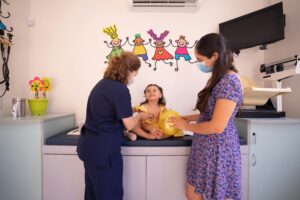 Silver-Russell syndrome (SRS) is a rare disease with an incidence of 1:30,000 to 1:100,000 newborns. Due to apparent clinical heterogeneity, a large proportion of patients with SRS are undiagnosed. The main characteristics of the syndrome are intrauterine retardation and postnatal growth retardation, dysmorphic stigmas, and malformations of other organs and systems.
Silver-Russell syndrome (SRS) is a rare disease with an incidence of 1:30,000 to 1:100,000 newborns. Due to apparent clinical heterogeneity, a large proportion of patients with SRS are undiagnosed. The main characteristics of the syndrome are intrauterine retardation and postnatal growth retardation, dysmorphic stigmas, and malformations of other organs and systems.
In this article, a 7-year-old girl with clinical data (intrauterine hypotrophy, unsatisfactory postnatal growth, more apparent in terms of weight, dysmorphic stigmas) is presented. The diagnosis is confirmed at 10 months of age by DNA analysis – 11p15. Treatment with growth hormone is started under the Bulgarian Christmas charity initiative at 5 years and 8 months of age.
At 7 years of age, the standard deviations for height and weight are -0.8. The height still does not match the genetic prediction. The lag in psychomotor development has been overcome, and the child meets the criteria for “school maturity”.
The SRS diagnosis is made in a timely manner thanks to systematic preventive examinations and the evaluation of auxological indicators. Treatment follow-up and her condition monitoring plans for the family and family physician are established, focused on regular preventive examinations, interpretation of results, active search for symptoms of hypoglycemia, side effects from treatment with growth hormone, and other congenital conditions.
Systematic and conscientiously conducted prophylactic examinations and interpretation of the results are key moments for assessing the child’s growth and development, including the ability to detect rare diseases. The cooperation of the family, the trust in the general practitioner, and the team of consultants are the basis for raising a child with a rare disease. Read the full article here.
